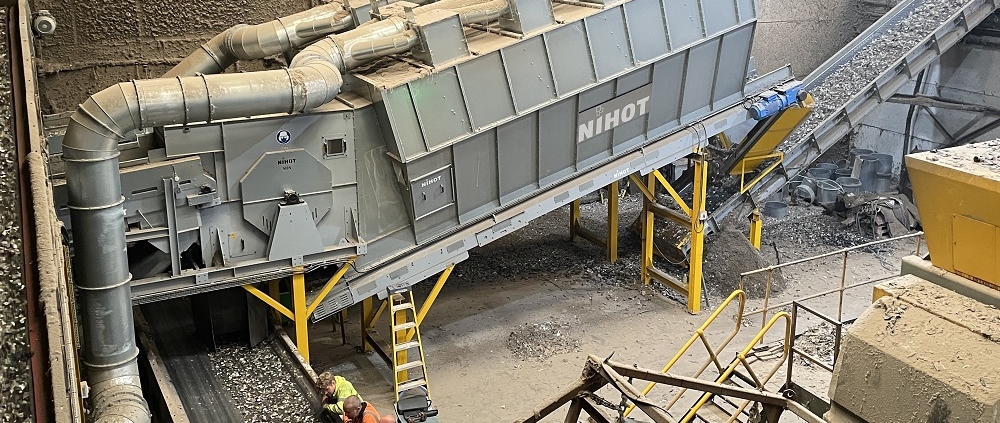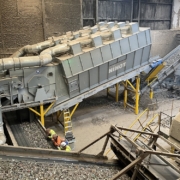How Densimetric Separators Work in Waste Management

Densimetric separators are devices used to classify materials according to their density. Their operation is based on the difference in weights between the elements, which allows efficient separation in various industrial environments. These systems can operate with air, depending on the separation method chosen. They are essential in waste management and recycling processes, helping to optimize material recovery. In this article we will discover how densimetric separators work in waste management.
Principles of Operation of Densimetric Separators
Densimetric separators are based on physical principles to classify materials by density, using air flows. These methods enable efficient separation of components in various industrial and recycling applications.
Use of Air in Separation
The operation of densimetric separators is based on the use of as separation media, each with its own specific techniques.
Air Flow Separation
Air separation involves the incorporation of a system of conveyor belts and pressurized air generators. This method allows sorting of light materials, such as paper and plastic, which are lifted by the air flow, while denser materials fall onto a different belt.
Importance of Density in Separation
Density is a crucial factor in the operation of densimetric separators. As materials are analyzed, differences in density allow clear criteria for their separation to be established. This optimizes sorting processes, improving the quality of recovered materials and facilitating their further treatment in recycling and production industries.
Separation Technologies and How They Work
Separation technologies are fundamental to optimize the material sorting process. These techniques allow a more accurate and efficient separation, adapting to different types of waste and their characteristics. The main systems used are detailed below.
Conveyor Belt Systems
Conveyor belt systems are essential in densimetric separators. These belts allow the continuous transport of materials throughout the separation process. They are designed to operate at various inclines and lengths, adapting to the specific workflow of each installation. The belts facilitate the homogeneous distribution of materials, which is crucial for effective separation.
Sorting Tables and Screens
Sorting tables and screens are key tools in the separation process. These devices help classify materials according to their physical characteristics and densities.
Disc Screens
Disc screens use a system based on rotating discs that classify materials according to their size. These screens are ideal for separating particles of different dimensions, improving efficiency in the classification of various wastes.
Advanced Technology Applications
The incorporation of advanced technologies in densimetric separators allows for more accurate sorting. Technologies such as image analysis and density sensors have revolutionized the operation of these systems. These innovations not only improve efficiency, but also increase the quality of separated materials, helping to optimize production processes related to waste management.
Applications in Waste Management
Densimetric separators play a crucial role in waste management, facilitating the sorting and recycling of various materials. Their use in various applications contributes to a more efficient and sustainable management of resources.
Solid Waste Recycling
In recycling plants, densimetric separators are essential for the correct classification of the solid waste stream. Through processes that take advantage of the difference in density, it is ensured that recyclable materials are separated from those that are not. This separation process includes:
- Paper and cardboard, which are sorted for subsequent recycling.
- Plastics, which are separated for reuse.
- Metals, which are extracted to be treated in recovery processes.
Construction Waste Separation
In the construction industry, densimetric separators are used to classify debris generated during construction sites. This separation facilitates the recovery of recyclable materials, such as:
- Concrete that can be reused in new construction.
- Metals that are recyclable and contribute to the sustainability of the sector.
- Non-recyclable materials that can be managed more efficiently.
Role in the Circular Economy
Densimetric separators also facilitate the transition to a circular economy. By optimizing the recycling and reuse of materials, they contribute to reducing the volume of waste. This approach supports:
- The decrease in the extraction of natural resources.
- The reduction of pollution generated by waste.
- The promotion of sustainable practices in various industries.
Advantages and Benefits of Densimetric Separators
Densimetric separators offer multiple advantages that positively impact the efficiency of recycling processes and environmental sustainability. Some of their main benefits are detailed below.
Improved Sorting Efficiency
These automated systems optimize material separation, increasing the speed and accuracy of the process. Notable improvements include:
- Faster waste sorting, reducing processing times.
- Minimization of sorting errors, ensuring more effective recovery of recyclable materials.
- Adaptability to different waste streams, allowing its use in various industries.
Contribution to Recycling and Sustainability
Densimetric separators play a crucial role in driving the circular economy, facilitating recycling. Their contributions are:
- Increased quantity of recycled materials, which reduces pressure on natural resources.
- Improving the quality of recovered materials, making reuse processes more viable.
- Reduction of waste in landfills, contributing to a cleaner environment.
Cost Reduction and Quality Increase
The implementation of densimetric separators not only optimizes the process, but also generates direct economic benefits:
- Decreased long-term operating costs due to their efficiency.
- Improved materials management, resulting in maximized recycling revenues.
- Raised quality standards for recycled products, making them more competitive in the marketplace.
Challenges and Future Trends in Densimetric Separation
Densimetric separation faces multiple challenges and opportunities that will shape the future of this technology. These challenges need to be addressed to ensure effective and sustainable sorting in waste management.
Challenges in Density Variations
Variations in the density of recyclable materials are a significant challenge in the separation process. Factors such as heterogeneous waste composition and non-uniformity in particle size make accurate sorting difficult. Some of the main challenges include:
- Identification of materials similar in density that require more sophisticated techniques for separation.
- Development of adaptive systems that can adjust in real time to changes in waste stream composition.
- Optimization of air settings to maximize efficiency in separating narrower density ranges.
Technological Innovations in Separator Technology
Technological advances are transforming the way densimetric separators operate. The implementation of innovative technologies promises to improve process efficiency.
Artificial Intelligence Integration
Artificial intelligence is emerging as a key tool in optimizing densimetric separation. This technology can:
- Analyze real-time operating data to immediately adjust separation parameters.
- Predict patterns in material variability, enabling a more agile response to changes in composition.
- Facilitate machine learning to improve classification accuracy over time.
Adaptation to New Regulations
Evolving regulatory frameworks also pose challenges. Densimetric separators must be in compliance with increasingly stringent environmental regulations that seek to improve sustainability in waste management. This requires:
- Investment in cleaner and more efficient technologies that minimize environmental impact.
- Development of strategies that not only focus on separation, but also on improving the quality of recycled materials.
Are you looking for high efficiency densimetric separators to optimize your recycling processes? At Reverter Industries, we have custom-designed equipment to meet the specific needs of your operation. Our team of experts is ready to assist you in selecting the perfect solution. Contact us today and take the next step towards more efficient and sustainable recycling!





